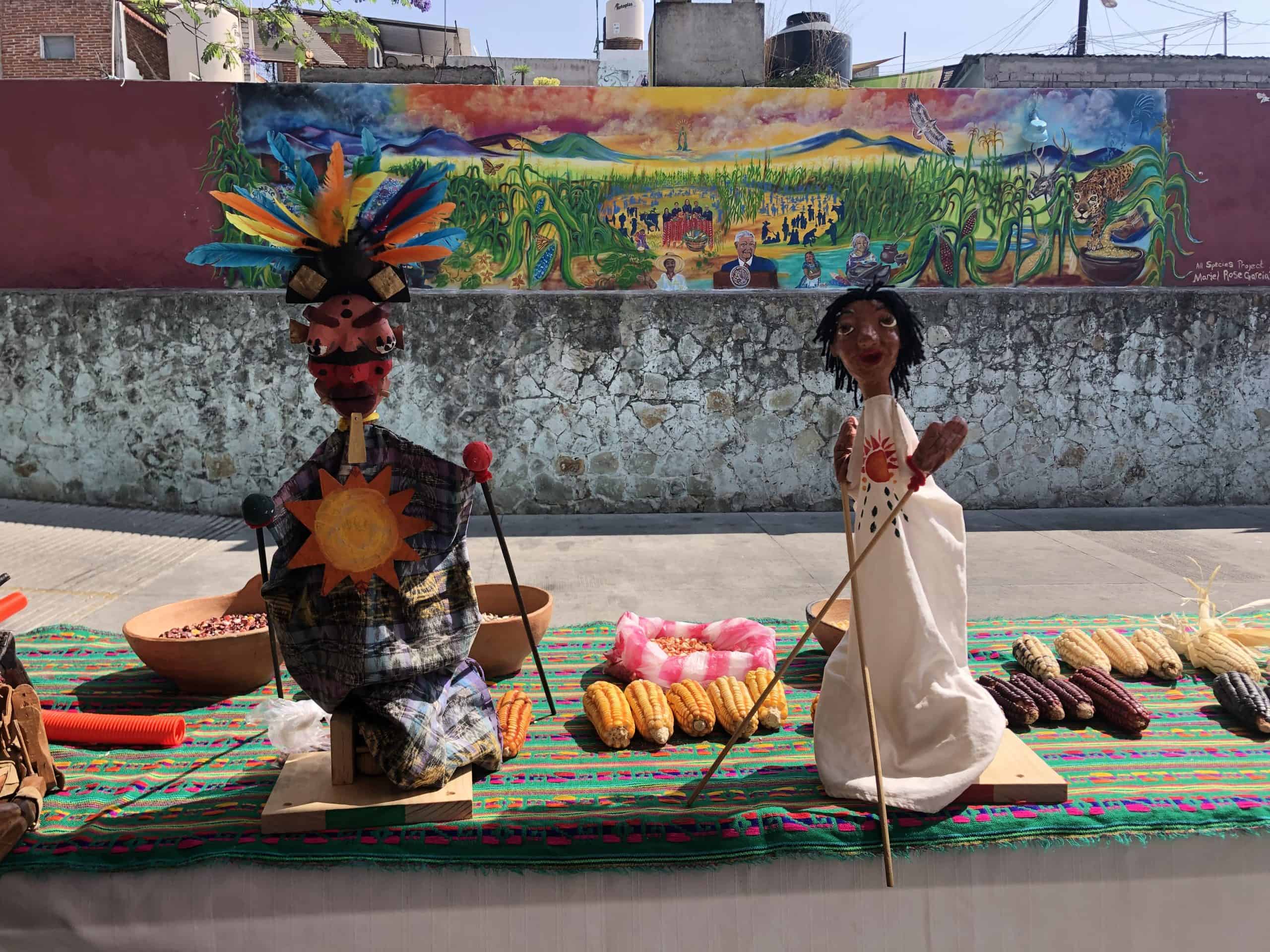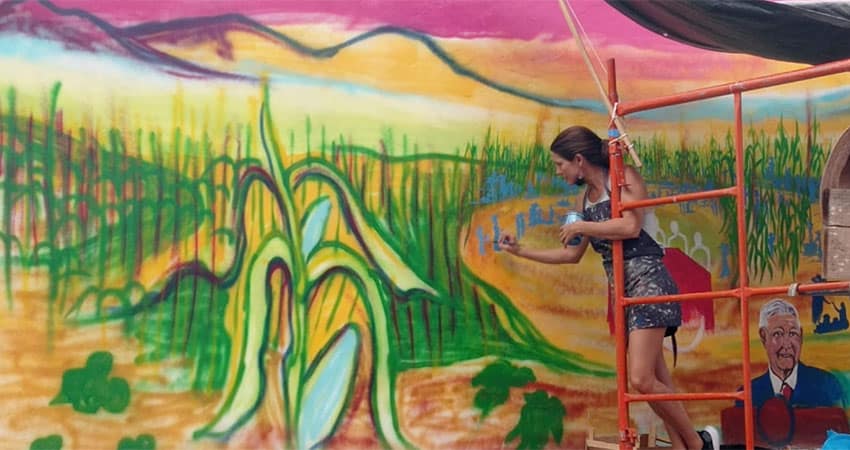In a noisy back entrance to one of the oldest markets in Oaxaca city’s oldest markets, not far from one of the sites where corn originated around 9,000 years ago, muralist Mariel García stood on a scaffold in the hot sun for three weeks and painted her heart out.
The mural she was creating, more than a year in the planning and execution, is a tribute to Mexico’s long struggle to protect the country’s more than 1,000 native maize varieties from contamination by genetically modified (GMO) corn.

Garcia is part of a binational collective of artists, scientists and activists that has been working for more than a decade to raise awareness about the need to protect the diversity of corn. And though García, born into northern New Mexico’s traditional corn culture and now living in Mexico, considers herself anything but political, the mural comes out of the highly-politicized context that surrounds corn.
“When you turn daily news into a mural, you turn it into a legend to be looked up to by students of history in the future… and this one tells the story of how all of Mexico came together to save the milpa culture,” explained Chris Wells, founder of the All Species Project, the engine behind the mural and García’s inspiration.
The milpa, the ancient and complex agricultural system that has supported life for millennia throughout Mesoamerica, is much more than corn, explained Wells. Recent studies have documented up to 191 different edible plants in a traditional milpa, including beans, squash, various varieties of chili peppers, tomatoes, edible greens and even medicinal plants. It is also a habitat for a wide variety of animals.
“The milpa is Mexico’s gift to the world,” said Wells.

In the best tradition of Mexican muralism Wells, a longtime native corn cultivator, songwriter and organizer from New Mexico residing in Oaxaca, worked with Garcia for a year planning the mural and inauguration and raising the money to cover expenses. Garcia and other collective members donated their time. The mural was the latest in a series of circuses, parades and even a traditional Oaxacan calenda – a dancing procession of giant puppets – to raise awareness in Mexico and in the U.S. about threats to native corn.
Corn has made headlines recently because of an ongoing trade dispute between the U.S. and Mexico, due to Mexico’s pending partial ban on glyphosate and on GMO corn. But the mural was originally conceived to celebrate a less prominent but much more powerful victory for native corn defenders: the approaching tenth anniversary of the Demanda Colectiva en Defensa del Maíz Nativo (Class Action Lawsuit in Defense of the Native Corn).
This lawsuit resulted in a decision by the Mexican Supreme Court to ban the production of GMO corn in Mexico.
Members of the All Species Project and the Demanda Colectiva gathered recently along with local market vendors, artists, performers, schoolchildren, city authorities and a host of other attendees to inaugurate García’s mural at the Sánchez Pascuas market, and to pay homage to that long and diverse movement with a mixture of art, culture and science.
The mural, the backdrop of the entire event, features a lush and verdant milpa. Superimposed on that greenery is a biodiverse cast of characters.
On the right are the deer and the jaguar and the red-tailed hawk; there’s the monarch butterfly and other pollinators; there are the corn and beans and quelites, or edible greens that have developed amongst the dozens of different foods and medicines that have evolved from this ancient agroecology.

Also depicted amid the milpa are the human elements behind that ecosystem: the campesinos who over millennia have developed more than a 1,000 corn varieties, each one specific to a particular bioregion.
There, too, is the Mexican Supreme Court, seated at the center in their black robes; the high court upheld the Demanda Colectiva’s appeal twice, most recently in 2021, in challenges by the binational seed companies including Monsanto.
“A genetically modified corn plant is a pesticidal plant,” said Dr. Ana Ruíz Díaz, a leader in the class-action lawsuit who spoke at the mural inauguration event. “Why? Because it expresses pesticides within itself and because those who eat it transmit these toxins to their descendants. Be it cattle, be it insects, be it human beings.”
Ruíz Díaz of the Demanda Colectiva hailed the mural as a way of keeping the memory alive of these two watershed moments in Mexico’s legal history.
“These are two results that we celebrate because the leadership of the Judiciary, that is, the Supreme Court of Justice of the Nation, ruled against the transnationals and against the Federal Executive Branch, that is, against the Secretaries of Environment and Agriculture, and ruled in favor of corn consumers.”
Juan Carlos Julián Morales of the Espacio Estatal del Maíz Nativo de Oaxaca (State Space for the Native Corn of Oaxaca), a collective of civil society and campesino organizations working to defend the diversity of corn, spoke of the importance of traditional and ancestral agricultural techniques.

“In many places in Oaxaca we still have the virtue that there is ancient peasant knowledge that you will not find in biology or science academies, and that, curiously, is our parents, our grandparents or our great-grandparents, still have. Sometimes it is enough to listen to them.”
The transmission of knowledge is fundamental, said Morales.
“Just as we inform them about GMOs, so, too, can they share information on how the corn is planted in the Sierra Norte, how a ritual is performed in the Isthmus of Tehuantepec, how the seeds are preserved by drying in the sun, or stored with ash, or with dry chile, epazote or hierba santa. All this knowledge must continue to be consolidated.”
Alejandro Jiménez Molina, a master puppeteer who has been called the “Geppetto of Oaxaca,” together with partner Soleil Marela, kicked off the inauguration of the mural with an engaging performance peopled with wooden campesinos, Zapotec deities and a fluffy green axolotl.
Pitao Cozobi, the plumed and imposing Zapotec god of corn, had choice words for a pair of campesinos who became ill after switching to a diet of crispy corn chips and soft drinks and no longer had the energy to tend to their milpa.
“Corn is our meat, our bones, our being, our life,” intoned Pitao Cozobi. “This is a mortal battle between the before and the now, these forces that are trying to change what for more than 10,000 years the peoples of Mesoamerica have achieved: a corn that even today sates the hunger of many peoples.”
Tracy L. Barnett is a freelance writer based in Guadalajara. She is the founder of The Esperanza Project, a bilingual magazine covering social change movements in the Americas.
